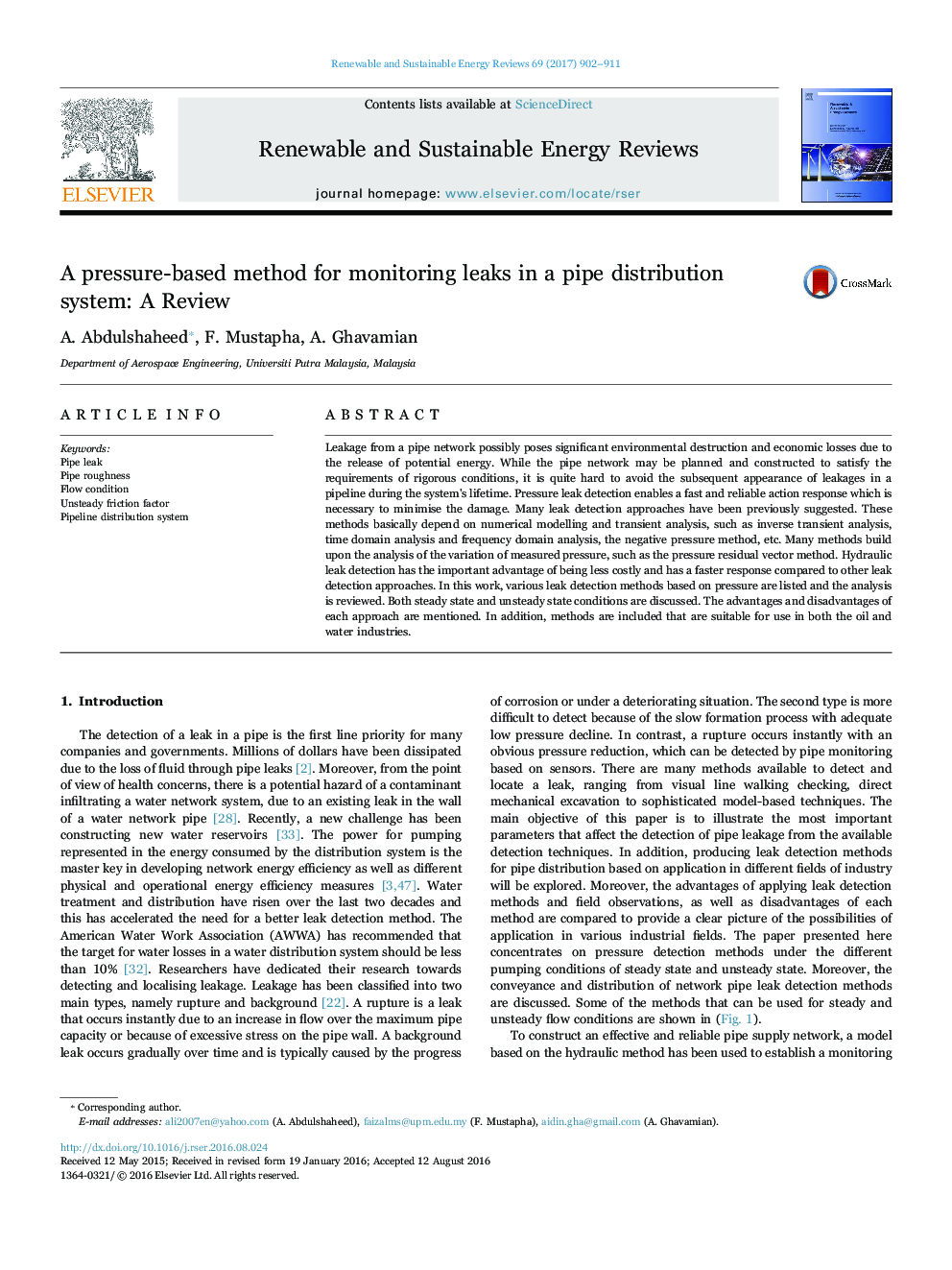| کد مقاله | کد نشریه | سال انتشار | مقاله انگلیسی | نسخه تمام متن |
|---|---|---|---|---|
| 5483382 | 1522317 | 2017 | 10 صفحه PDF | دانلود رایگان |
عنوان انگلیسی مقاله ISI
A pressure-based method for monitoring leaks in a pipe distribution system: A Review
ترجمه فارسی عنوان
یک روش مبتنی بر فشار برای نظارت بر نشت در یک سیستم توزیع لوله: یک مرور
دانلود مقاله + سفارش ترجمه
دانلود مقاله ISI انگلیسی
رایگان برای ایرانیان
کلمات کلیدی
نشت لوله زبری لوله، شرایط جریان ضریب اصطکاک نامنظم، سیستم توزیع خط لوله،
ترجمه چکیده
نشتی از یک شبکه لوله احتمالا باعث تخریب محیط زیست و زیان های اقتصادی ناشی از انتشار انرژی بالقوه می شود. در حالی که شبکه لوله ممکن است برنامه ریزی شده و ساخته شده برای برآورده شدن الزامات شرایط سخت، دشوار است برای جلوگیری از ظهور پس از نشت در یک خط لوله در طول عمر سیستم. تشخیص نشت فشار باعث پاسخ سریع و قابل اطمینان به عمل می شود که برای آسیاب کردن ضروری است. بسیاری از روش های تشخیص نشت قبلا پیشنهاد شده اند. این روشها عمدتا به مدلسازی عددی و تجزیه و تحلیل گذرا بستگی دارد، مانند تجزیه و تحلیل گذرا معکوس، تجزیه و تحلیل دامنه زمان و تجزیه و تحلیل فرکانس، روش فشار منفی و غیره. بسیاری از روشها براساس تجزیه و تحلیل تغییرات فشار اندازه گیری، مانند فشار باقی مانده روش بردار تشخیص نشت هیدرولیکی مزیت مهمی است که هزینه کمتری دارد و پاسخ سریعتری نسبت به سایر روشهای تشخیص نشتی دارد. در این کار، روش های تشخیص نشتی مختلف بر اساس فشار ذکر شده و تجزیه و تحلیل مورد بررسی قرار گرفته است. هر دو وضعیت حالت ایستا و حالت ناپایدار مورد بحث قرار گرفته است. مزایا و معایب هر رویکرد ذکر شده است. علاوه بر این، شامل روش هایی است که برای استفاده در صنایع نفت و آب مناسب هستند.
موضوعات مرتبط
مهندسی و علوم پایه
مهندسی انرژی
انرژی های تجدید پذیر، توسعه پایدار و محیط زیست
چکیده انگلیسی
Leakage from a pipe network possibly poses significant environmental destruction and economic losses due to the release of potential energy. While the pipe network may be planned and constructed to satisfy the requirements of rigorous conditions, it is quite hard to avoid the subsequent appearance of leakages in a pipeline during the system's lifetime. Pressure leak detection enables a fast and reliable action response which is necessary to minimise the damage. Many leak detection approaches have been previously suggested. These methods basically depend on numerical modelling and transient analysis, such as inverse transient analysis, time domain analysis and frequency domain analysis, the negative pressure method, etc. Many methods build upon the analysis of the variation of measured pressure, such as the pressure residual vector method. Hydraulic leak detection has the important advantage of being less costly and has a faster response compared to other leak detection approaches. In this work, various leak detection methods based on pressure are listed and the analysis is reviewed. Both steady state and unsteady state conditions are discussed. The advantages and disadvantages of each approach are mentioned. In addition, methods are included that are suitable for use in both the oil and water industries.
ناشر
Database: Elsevier - ScienceDirect (ساینس دایرکت)
Journal: Renewable and Sustainable Energy Reviews - Volume 69, March 2017, Pages 902-911
Journal: Renewable and Sustainable Energy Reviews - Volume 69, March 2017, Pages 902-911
نویسندگان
A. Abdulshaheed, F. Mustapha, A. Ghavamian,
